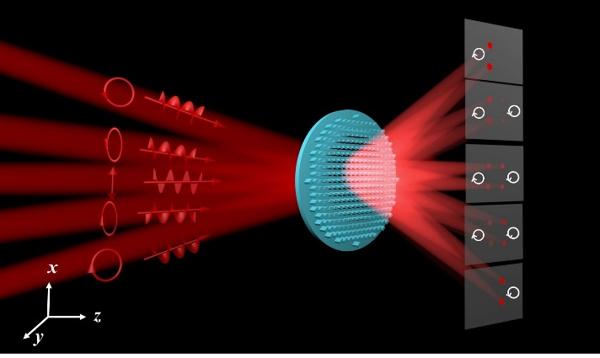Miniaturization and integration are inevitable trends in development of modern communication systems. In addition, with increasing of the communication capacity, the independent manipulation of multiple spin beams with controllable energy allocation enables practical applications in multiple-target detection radar system, multiple-input multiple-output (MIMO) communications, and so on.
The exotic properties of metasurfaces have provided new opportunities to develop various types of ultra-thin and ultra-compact metalenses with unusual functionalities, which are ideal for device miniaturization and system integration (for manipulating spin electromagnetic (EM) waves). However, a geometric-phase-based optical device that can integrate the function of a spin-decoupled lens with intensity-tunable functionality between helicity-dependent focal points hasn't been reported.
In fact, geometric-phase-based (or Pancharatnam-Berry phase-based) metasurfaces (geometric metasurfaces) enable an unprecedented capability to control the phase, polarization, and amplitude of circularly-polarized EM waves by arranging the orientation angle (θ) of each anisotropic antenna. Geometric metasurfaces with predesigned phase profiles are robust against fabrication tolerance (antennas size and roughness) and materials property variations.
However, the inherent conjugated symmetry, i.e. equal and opposite phase distributions under the illumination of left-hand polarized (LCP) and right-hand polarized (RCP) EM waves, inevitably hinders geometric metasurfaces to implement spin-decoupled/switchable functionalities.
To overcome this limitation, the traditional approach is to combine the geometric phase and propagation phase (dynamic phase) together to decouple spin-locking between two helicity components. However, the traditional method that can independently manipulate two orthogonal helicity components, inevitably needs to do a large number of parameters scanning to achieve the desired unit cells, which means that it is very complicated to design a spin-decoupled metalens based on the previous method.
Recently, Prof. Xiaofei Zang and Yiming Zhu from Terahertz Technology Innovation Research Institute, Terahertz Spectrum and Imaging Technology Cooperative Innovation Center, University of shanghai for Science and Technology have proposed a flexible approach that can address the previous issues.
Unlike the previous spin-decoupling approach depending on the joint modulation of geometric phase and propagation phase, an approach based on the pure geometric phase is proposed to design spin-decoupled metalens that can independently modulate each spin state and intensity ratio of the spin EM waves, leading to a spin-decoupled metalens with intensity-tunable multiple focal points (see Fig. 1). The intensity ratio between LCP and RCP multiple focal points can be arbitrarily and continuously controlled with different weights of LCP and RCP incident THz waves.
This method has obvious advantage in the simplicity of designing the spin-decoupled metasurfaces (without a large number of parameters scanning) that can independently manipulate two orthogonal helicity components.
In addition, our unique design will enable metalenses with unusual functionalities that are very difficult or impossible to achieve with conventional lenses. The simplicity and robustness of our design not only provide a platform for simultaneous generating helicity-dependent focal points and controlling the intensity-ratio between them, but also open an avenue for designing multifunctional devices and integrated systems. Related research results are published in Photonics Research, Vol. 9, Issue 6, 2021. (Bingshuang Yao, Xiaofei Zang, Yang Zhu, Dahai Yu, Jingya Xie, Lin Chen, Sen Han, Yiming Zhu, Songlin Zhuang. Spin-decoupled metalens with intensity-tunable multiple focal points[J]. Photonics Research, 2021, 9(6): 06001019)

Fig. 1 Spin-decoupled metalens with intensity-tunable multiple focal points.
In summary, the approach demonstrated in this work provides a flexible platform that can independent manipulate the two orthogonal spin states of spin EM waves using the spin-decoupled metalens.
The next thing the team will do is to realize multiplane imaging (e.g. generating multiple images with controllable contrast ratio) based on the proposed spin-decoupled metalens with intensity-tunable multiple focal points. Since the intensity of each focal point can be controlled by changing the ellipticity of incident EM waves, the contrast ratio of multiplane imaging can also be realized by the designed metalens.
In addition, by joining the modulation of helical phase, the spin-decoupled metasurface can be applied to independently control/design the helicity-dependent vortex beams, and even to obtain some special beams by the superposition of helicity-dependent vortex beams.


